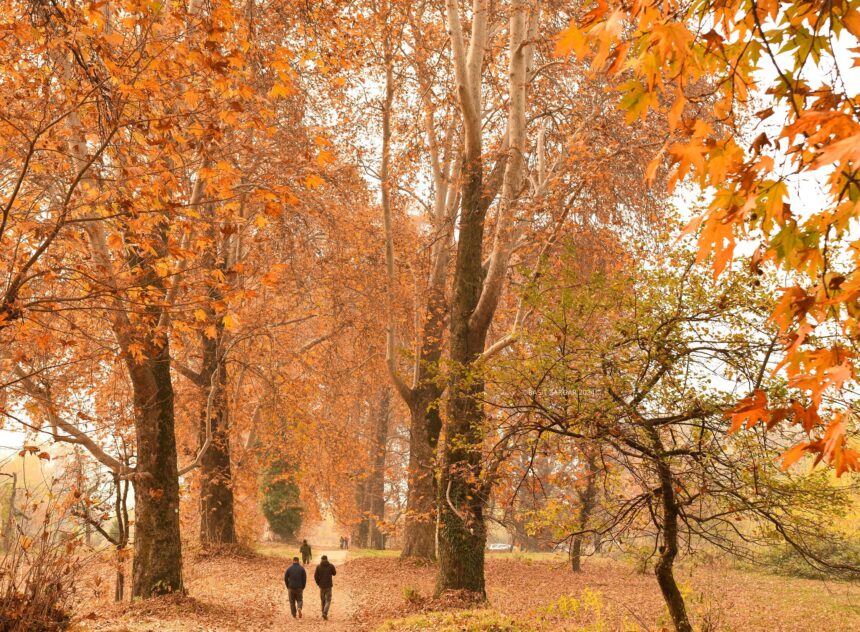The Kashmir Valley is experiencing a remarkable surge in tourist activity this autumn, characterized by an influx of visitors and increased flight traffic. With nearly 11,000 tourists arriving daily via air, the region is witnessing a revival of its tourism sector, which has long been celebrated for its breathtaking natural beauty. This article explores the factors contributing to this seasonal boom, the experiences of visitors, and the implications for local businesses.
A Flourishing Autumn Season
As autumn descends upon Kashmir, the landscape transforms into a vibrant tapestry of colors. The iconic Chinar trees, with their striking red and gold leaves, create stunning vistas that attract travelers from across India and beyond. The season, known locally as Harud, is not just a visual spectacle; it represents a cultural moment for locals who cherish the beauty and serenity of this time of year.
Recent reports indicate that Srinagar Airport has been bustling with activity, handling up to 70 flights per day over the past three days. On November 20 alone, the airport recorded 11,216 passengers, highlighting the growing interest in visiting the valley. Local shopkeepers and residents are delighted by this influx, with many expressing their excitement about welcoming first-time visitors who are awestruck by Kashmir’s beauty.
Visitor Experiences: A Journey to Remember
For many tourists, this autumn marks their first visit to Kashmir, and their reactions reflect a deep appreciation for the region’s charm. Rahul Sharma, a tourist from Gujarat, shared his enthusiasm: “I heard so much about the beauty of Kashmir, especially in autumn. It is my first time here, and I can say it’s beyond what I imagined.” His companion, Neha, echoed these sentiments: “The beauty of Kashmir is out of this world; it feels like heaven. At least for a single time, one should visit Kashmir.”
These firsthand accounts underscore the emotional connection that visitors develop with the valley. The combination of stunning landscapes, rich cultural heritage, and warm hospitality creates unforgettable memories that resonate long after their departure.
Economic Impact: Boosting Local Businesses
The resurgence in tourism is not only beneficial for visitors but also has significant positive implications for local economies. Business owners across various sectors are reporting increased activity. Asim Bhat, a houseboat owner in Srinagar, noted that “the increase in visitors has been good for business. Our houseboats are packed and have been fully booked.” This uptick in bookings extends beyond accommodations; local artisans and shopkeepers are also experiencing heightened demand for handicrafts and souvenirs.
The Jammu and Kashmir Tourism Department has actively promoted autumn tourism through social media campaigns and collaborations with influencers, further enhancing visibility and attracting more visitors to the region. This strategic marketing effort has played a crucial role in revitalizing interest in Kashmir as a travel destination.
Looking Ahead: Winter Tourism on the Horizon
As winter approaches, anticipation is building for snowfall in the higher altitudes of Kashmir. This seasonal shift is expected to draw even more tourists seeking adventure sports such as skiing and snowboarding at renowned resorts like Gulmarg. The convergence of autumn’s picturesque landscapes and winter’s thrilling activities positions Kashmir as a premier destination for diverse types of travelers.
The dual appeal of autumn and winter tourism not only promises to sustain visitor interest but also ensures ongoing economic benefits for local communities dependent on tourism. With its enchanting scenery and rich cultural experiences, Kashmir continues to captivate hearts and inspire wanderlust among those who venture into its breathtaking landscapes.
Kashmir valley is basking in the glory of autumn and preparing for winter’s arrival. Its natural beauty and resilience is an open invitation for the paradise seekers. Valley beckons travelers from all corners of the globe.







